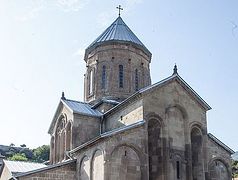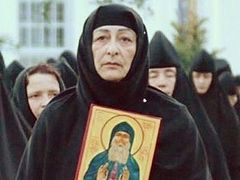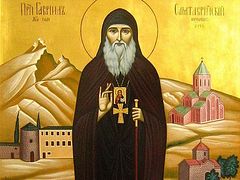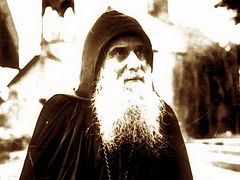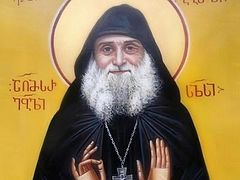The Samtavro Convent of St. Nina in Mtskheta in Georgia is known far beyond its borders. We spoke with Nun Gabriela (Kvastiani), tonsured on the day of St. Gabriel (Urgebadze) with his name (the first tonsure in the monastery’s history in the name of Elder Gabriel), about Samtavro and its monastic way of life.
 Samtavro Monastery, where the grave of St. Gabriel is located, and after the uncovering of his relics—a place of veneration
Samtavro Monastery, where the grave of St. Gabriel is located, and after the uncovering of his relics—a place of veneration —Tell us about Samtavro Monastery, where you live, please.
—Our Samtavro Convent of the Equal-to-the-Apostles St. Nina is located in the city of Mtskheta. It’s an ancient Georgian city—our first and spiritual capital. It’s six miles from Tbilisi. Our monastery is stavropegial, that is, under the direct jurisdiction of the Patriarch.
According to Church Tradition, when the Equal-to-the-Apostles St. Nina came to Georgia to preach Christianity with a cross made of grapevine, she chose Mtskheta as her place to stay and settled in the royal garden (the territory of Samtavro Monastery). She preached Christianity, healed the sick, and most importantly—she converted Queen Nana and King Mirian to Christianity. As a result, an exceptional event in world Orthodoxy occurred: The entire Georgian people accepted Christianity in one day. Virgins settled around St. Nina, whom she instructed, and they lived as a monastic community. Thus, the history of female monasticism in Georgia takes its beginning in our monastery from the time of St. Nina.
A great saint of our time, known throughout the world, Elder Gabriel (Urgebadze), finished his earthly path in Samtavro Monastery, according to his prayers; he was the spiritual father for the monastery his last ten years, and now he is its spiritual protector. His Holiness and Beatitude Catholicos-Patriarch Ilia II of All Georgia has an especially heartfelt disposition towards the monastery, as his Godmother was the abbess of Samtavro, and in his childhood years His Holiness often visited the monastery, where the Lord vouchsafed him His visitation and illumination.
—Please tell us about the way of life in your monastery and about your sisters—how many there are.
—There are fifty-seven sisters living in the monastery today. Two are novices and the rest are riassophore and full nuns. We have an Athonite charter, from Iveron Monastery. Prayers first began to rise up from here in the fourth century, when St. Nina lived here. There’s been a bishop’s cathedra and men’s monastery since the fifth century. The convent was founded in 1820. The renewer of the monastic life was St. Nina (Amilakhvari I), who was canonized together with her niece, the abbess of the monastery St. Nina (Amilakhvari II), and St. Tamar (Mardzhanishvili) in one day—December 22, 2016. By the way, that was the first time in the entire history of the Georgian Orthodox Church that abbesses were canonized, and it’s interesting that two of them were from our monastery.
So, our rule is Athonite. Every night we keep vigil. We rise at 3:20, we do our cell rule until 4:00 in the morning, then at 4:00 we have Midnight Office. That lasts until 6:30, then there’s an hour and a half or two hours of rest and then Liturgy. During Liturgy, some go to the service and some to their obediences.
The mothers who don’t have physical obediences anymore due to age go to Liturgy. We have it in two churches: There’s early Liturgy at 6:00 or 7:00 in the little Church of St. Nina several times a week, and in the main cathedral church at 9:00. On feast days or for Patriarchal services the Liturgy begins at 10:00.
Obediences last until 7:00 or 8:00 at night. After that there’s evening prayers at 8:00. It’s common prayer, strict attendance—it’s forbidden to miss the prayer rule without a good reason. It lasts about an hour.
We go to sleep no earlier than 10:00 at night and no later than 11:00. Only five to six hours are allotted for sleep. Whoever can may sleep another hour or hour and a half in the morning after Midnight Office, but not everybody is able. But, in principle, five to six hours for sleep—that’s normal and enough for an adult, especially a monk or nun.
—What other features distinguish your monastery from others?
—A distinctive feature of Samtavro is, above all, that it was precisely here that Christianity became the state religion, that is, the spiritual foundation of social and political life was laid here, based on Orthodoxy.
Also, our Samtavro chant is praised even outside of Georgia and greatly loved by our Patriarch.
I have to tell you separately about our abbess—the spiritual mother of all Georgia. She has spiritually raised the abbesses of many Georgian convents. The Lord is merciful to us, after all, we have a spiritual father—Patriarch Ilia II, and a spiritual mother—Abbess Ketevan, who possesses a greatly loving heart and bears all our sorrows and illnesses with patience and humility. For many years she served the Patriarch as a novice and as a nun was sent to Samtavro, and here St. Gabriel (Urgebadze) spiritually supported her. Fr. Vitaly (Sidorenko) dressed her in the mantia before her tonsure and gave her an icon of the Theotokos “the Abbess.” She writes spiritual verses that are sung at the main national feasts. Most importantly: She bears love and kindness for every person within herself, for her Patriarch and homeland, and love for Christ. They’re preparing to publish a book about Abbess Ketevan in Moscow right now.
When you see pilgrims coming to us, they share their impressions and say they feel some kind of ancient ascetical spirit in our monastery. Apparently, the prayers of our ancestors and our saints are doing their job. The monastic pilgrims especially feel it. It especially draws them, of course, to our monastery.
And, of course, not only do our visitors feel the ascetic spirit of the ancient saints, but also the love of Elder Gabriel. They say they feel him, Batiushka Gabriel, everywhere here. They come to venerate and pray to him and they tell us such amazing stories—how people are healed physically and spiritually and what miracles occur through the elder’s prayers.
—Tell us, for example, can the nuns choose their own books they want to read, or do you have to get a blessing for everything?
—Yes, everything is done with a blessing. A nun doesn’t even have the right to leave the site of her obedience without a blessing, even if she just has to go to her cell for ten minutes. We have to let the deaness know. During the time for obediences you don’t even have the right to go to church without a blessing.
—Can you tell us about the confession of thoughts as it’s practiced there?
—We do it in writing. If you’re disturbed by any thoughts, you can write the abbess a note and drop it in a special box, and the abbess will read it and consider how to solve the problem on an individual basis.
—Are you allowed to use phones?
—Not everyone has a blessing for a phone—only those who need them for their obediences. Several of the nuns, especially the young ones, have no phone at all. Others have a regular pushbutton phone, and some with internet access if its needed for their obedience; but it’s all only with the blessing of the abbess. The time for using a phone is limited too.
—Are the sisters allowed to leave the territory of the monastery?
—No, we don’t leave. If we do, when necessary, it’s only with a blessing and in a pair—we don’t leave by ourselves.
—How many sisters live in each cell?
—Two sisters, sometimes three, but mostly two. The cells are partitioned off, so there’s a chance to retire.
—What do you eat in the monastery?
—As in all monasteries, meat is excluded. On non-fasting days we have fish and dairy products.
—Are all your nuns from Georgia?
—All the sisters were born in Georgia. The services are celebrated in Georgian. We speak Russian with guests from Russia and English with guests from other countries. But in general, we really love Russians and Russia, of course—just like Elder Gabriel.
—I was in Georgia and saw for myself how the ordinary people are disposed towards Russia. What I saw and heard strongly diverges from the picture you get from television.
—By the way, saints from Russia always played an active spiritual role in the life of our monastery. The monastery resumed its activity in 1820 by the efforts of the women’s community headed by St. Nina (Amilakhvari I). Then the abbesses of the monastery often visited Russia. St. Nina (Amilakhvari II) maintained spiritual communication with St. John of Kronstadt and Grand Duchess Elizabeth Feodorovna, who provided assistance and support to the monastery.
In 2020, Samtavro Monastery is celebrating the 200th anniversary of the resumption of its activity; the sisters are in constant labors for the glory of God, and St. Gabriel (Urgebadze) is waiting for all of you here in Samtavro…








